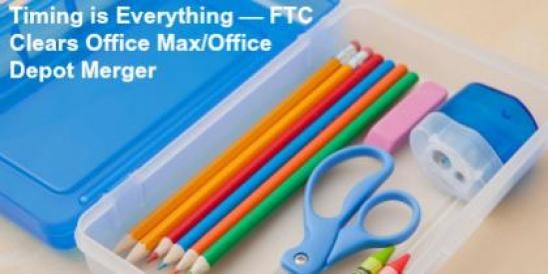In 1997, the FTC successfully challenged the merger between Staples and Office Depot, two of the three office supply superstores. Fast forward sixteen years to November 1, 2013, when the FTC closed its investigation of the proposed merger between Office Max and Office Depot, again two of the three office supply superstores. The decision to allow this merger to proceed shows how changes in competitive facts can change merger decisions and provides valuable lessons about how the agencies analyze mergers today.
In the 1997 Staples matter, the FTC — and the district court — focused on the quantitative evidence that prices for office consumables like pens, paper and ink were higher in geographic markets where only one or two of the three office supply superstores were present. Other retailers selling the same products, such as Wal-Mart, did not seem to affect prices. That quantitative evidence was backed up by internal company documents describing pricing strategies that focused nearly exclusively on the other two superstores. Finally, the court also took notice that these stores had a different "appearance, physical size, format… and variety" than other sellers of the same products. For all those reasons, the court agreed with the FTC's charge that the merger would harm competition and the deal was abandoned.
In its 2013 closing statement for the Office Max/Office Depot merger, the FTC explicitly stated that it conducted an identical quantitative analysis — but the results were very different. Now, the number of superstores in a given geographic area seemed to have no effect on prices for office consumables. The internal documents again confirmed the quantitative findings, this time showing management very concerned about the prices available at brick-and-mortar competitors like Wal-Mart, Target, Costco and Sam's Club. Also, the merging parties were "acutely aware" of the explosive growth of Amazon and other online retailers and the need to devise strategies to combat in-store or online comparisons with those competitors. As a result of these changes, the parties now usually price nationally and any local prices account for many competitors. Without defining any particular product or geographic market, the FTC felt confident that the transaction would not harm competition among retail consumers.
The FTC also looked at a new set of customers: large multi-regional customers who buy office consumables on a contract basis and require large quantities delivered to multiple offices across the country. Even here, the FTC saw several reasons why the transaction would not harm competition. First, there are other competitors for the business of these large contract buyers, including W.B. Mason, joint ventures of local office supply companies and even janitorial companies that can also provide these office supplies. Also, these customers have successfully used strategies to keep the superstores on their toes, including sourcing products like toner cartridges directly from the manufacturers and buying some products from multiple sources. As a result, these large contract buyers convinced the FTC that the merger gave them nothing to fear.
The FTC's analysis holds several lessons, even for companies outside the office supply industry. First, where the agency has used a particular analysis to challenge a merger in the same industry in the past, the parties should expect to see that analysis again and must be prepared to show factual changes that should change the result. Also, those changes need not be limited to new competitors, such as Amazon and the enhanced product offerings from Wal-Mart and Costco here. The FTC recognized that changes in buyer behavior can also affect the competitive dynamics, such as "showrooming" by retail buyers and various tactics by large contract buyers. But while the agency might be receptive to new factors that support the transaction, they will also be on the lookout for new small segments of buyers who might be harmed. In this investigation and in the recent Express Scripts/Medco merger of pharmacy benefit managers, the FTC looked at large buyers requiring national supply but found sufficient competition for even those buyers with particular needs.
Finally, this transaction confirms what all merger practitioners know: These investigations are very fact-intensive and it is the agency's beliefs about the current and expected competitive conditions, not any historical facts, that will drive the decision. So this merger joins XM/Sirius and Whirlpool/Maytag, but not DirecTV/Dish, as mergers between two of a seemingly small number of competitors that were reviewed and approved by the agencies when the facts were right for the parties.


 i
i

